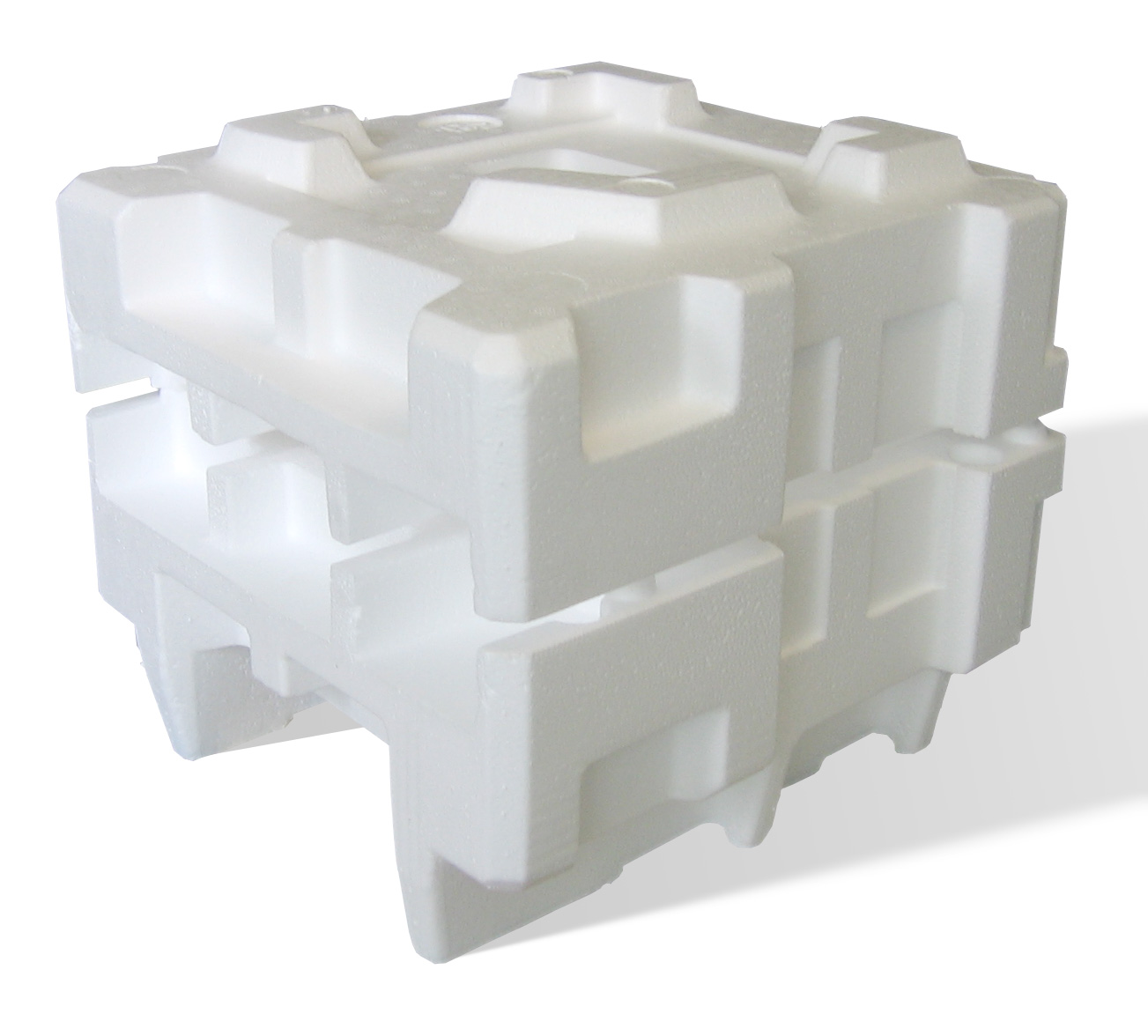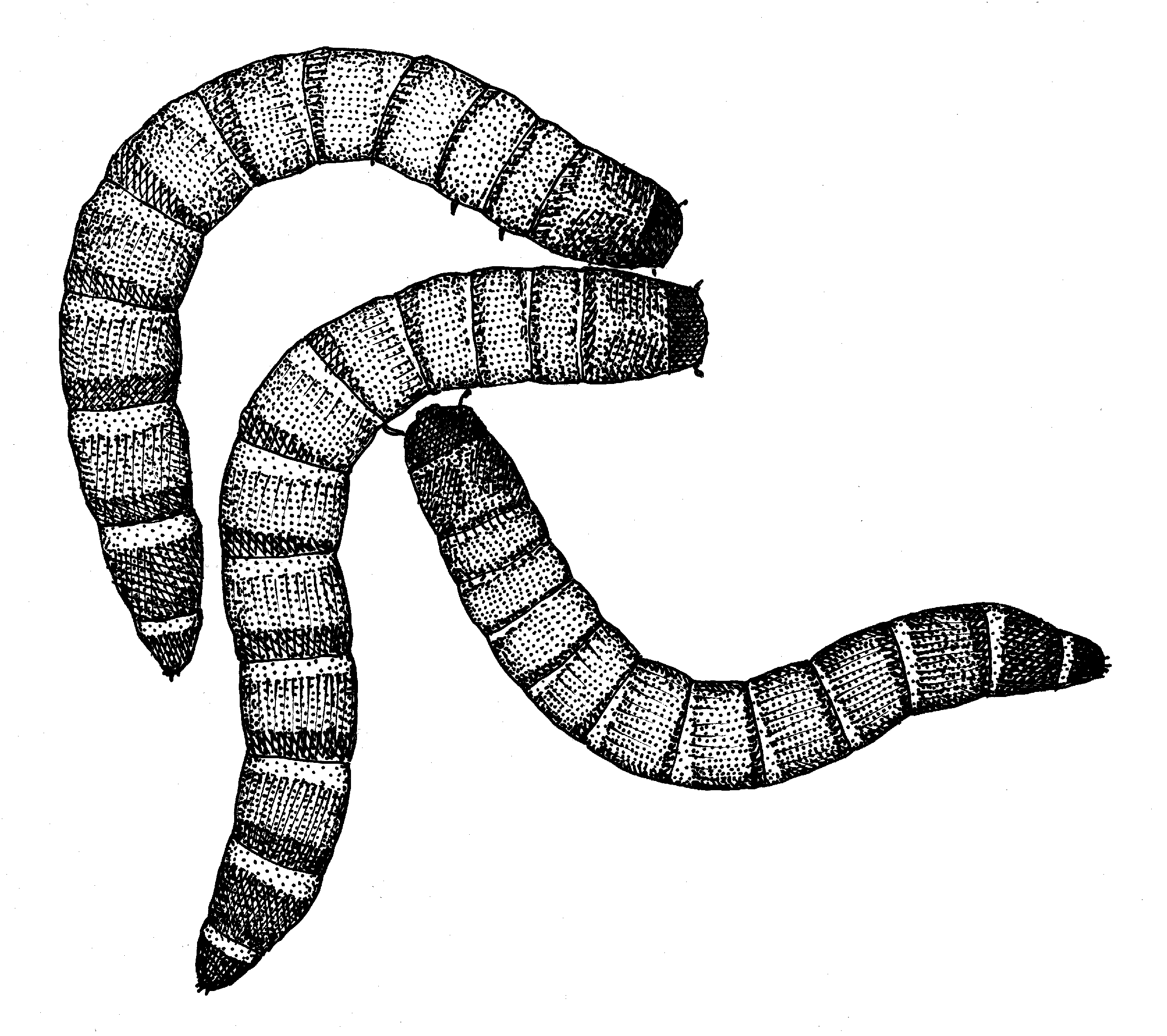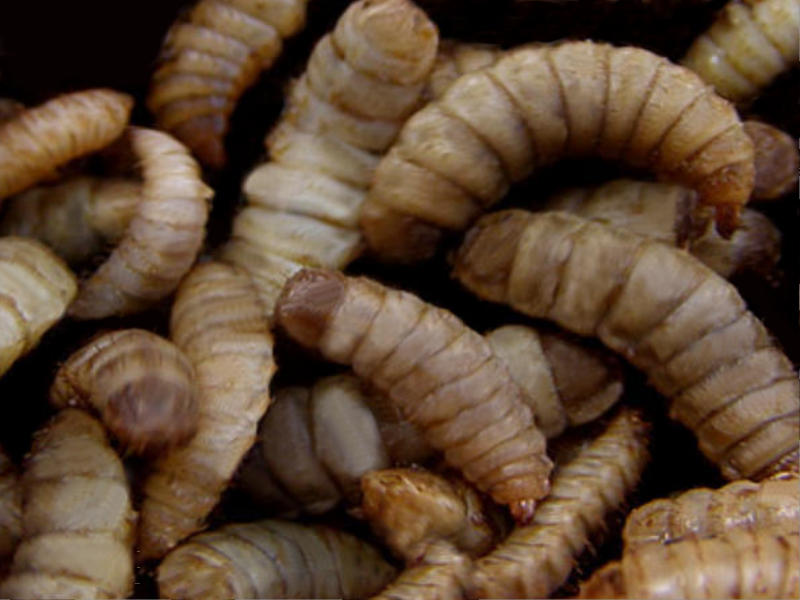|
Superworm
''Zophobas atratus'' is a species of darkling beetle, whose larvae are known by the common name superworm, kingworm, barley worm, morio worm or simply Zophobas. Superworms are common in the reptile pet industry as food, along with giant mealworms (''Tenebrio molitor'' larvae treated with juvenile hormone). The larvae resemble very large mealworms, about 50 to 60 mm (1.7–2.25 in) long when full size, but unlike mealworms, the ends of their bodies are very dark, almost resembling a black color. Once they reach sufficient maturity, the larvae pupate, emerging with a white to light brown colour; eventually darkening to black. The larvae fail to pupate if kept in a high density with many other larvae and plentiful food. Keeping ''Z. atratus'' this way is commonly used to hinder pupation. To mature the larvae, they must be isolated for about 7–10 days. They will then, upon maturation, emerge from their pupal stage as darkling beetles. ''Zophobas atratus'' is generally a ... [...More Info...] [...Related Items...] OR: [Wikipedia] [Google] [Baidu] |
Polystyrene
Polystyrene (PS) is a synthetic polymer made from monomers of the aromatic hydrocarbon styrene. Polystyrene can be solid or foamed. General-purpose polystyrene is clear, hard, and brittle. It is an inexpensive resin per unit weight. It is a poor barrier to air and water vapor and has a relatively low melting point. Polystyrene is one of the most widely used plastics, with the scale of its production being several million tonnes per year. Polystyrene is naturally transparent to visible light, but can be colored with colorants. Uses include protective packaging (such as packing peanuts and optical disc jewel cases), containers, lids, bottles, trays, tumblers, disposable cutlery, in the making of models, and as an alternative material for phonograph records. As a thermoplastic polymer, polystyrene is in a solid (glassy) state at room temperature but flows if heated above about 100 °C, its glass transition temperature. It becomes rigid again when cooled. This te ... [...More Info...] [...Related Items...] OR: [Wikipedia] [Google] [Baidu] |
Darkling Beetle
Darkling beetle is the common name for members of the beetle family Tenebrionidae, comprising over 20,000 species in a cosmopolitan distribution. Taxonomy ''Tenebrio'' is the Latin generic name that Carl Linnaeus assigned to some flour beetles in his ''10th edition of Systema Naturae'' 1758–59. The name means "lover of darkness"; the English language term 'darkling' means "characterised by darkness or obscurity"; see also English 'tenebrous', figuratively "obscure, gloomy." Many Tenebrionidae species inhabit dark places; in genera such as ''Stenocara'' and ''Onymacris'', they are active by day and inactive at night. The family covers a varied range of forms, such that classification presents great difficulties. These eleven subfamilies were listed in the 2021 review by Bouchard, Bousquet, ''et al.'', updating a similar catalog from 2005.Bouchard, Patrice; Lawrence, John F.; Davies, Anthony E.; Newton, Alfred F. (2005"Synoptic Classification of the World Tenebrionidae (Insect ... [...More Info...] [...Related Items...] OR: [Wikipedia] [Google] [Baidu] |
Johan Christian Fabricius
Johann Christian Fabricius (7 January 1745 – 3 March 1808) was a Danish zoologist, specialising in "Insecta", which at that time included all arthropods: insects, arachnids, crustaceans and others. He was a student of Carl Linnaeus, and is considered one of the most important entomologists of the 18th century, having named nearly 10,000 species of animals, and established the basis for the modern insect classification. Biography Johann Christian Fabricius was born on 7 January 1745 at Tønder in the Duchy of Schleswig, where his father was a doctor. He studied at the gymnasium at Altona and entered the University of Copenhagen in 1762. Later the same year he travelled together with his friend and relative Johan Zoëga to Uppsala, where he studied under Carl Linnaeus for two years. On his return, he started work on his , which was finally published in 1775. Throughout this time, he remained dependent on subsidies from his father, who worked as a consultant at Frederiks H ... [...More Info...] [...Related Items...] OR: [Wikipedia] [Google] [Baidu] |
Beetles Described In 1776
Beetles are insects that form the order Coleoptera (), in the superorder Holometabola. Their front pair of wings are hardened into wing-cases, elytra, distinguishing them from most other insects. The Coleoptera, with about 400,000 described species, is the largest of all orders, constituting almost 40% of described arthropods and 25% of all known animal species; new species are discovered frequently, with estimates suggesting that there are between 0.9 and 2.1 million total species. However, the number of beetle species is challenged by the number of species in dipterans (flies) and hymenopterans (wasps). Found in almost every habitat except the sea and the polar regions, they interact with their ecosystems in several ways: beetles often feed on plants and fungi, break down animal and plant debris, and eat other invertebrates. Some species are serious agricultural pests, such as the Colorado potato beetle, while others such as Coccinellidae (ladybirds or ladybugs) eat aphids ... [...More Info...] [...Related Items...] OR: [Wikipedia] [Google] [Baidu] |
Tenebrioninae
Tenebrioninae is the largest subfamily of the darkling beetles (Tenebrionidae), containing flour beetles, among others. Tenebrioninae contains more than 20 tribes. Description Adults Adults are robust, mid-sized beetles that typically have elytra with some sort of corrugation on the upper side. They are typically black, dark brown or grey, and often have a satiny sheen. The body is shaped like a Capsule (pharmacy)#Two-part gel capsules, medication capsule or like a bullet; the legs can be short and stout or long and spindly. They eat both fresh and decaying vegetation, including vegetable produce, and several are commercially important pest (organism), pests of flour and other cereal products. The subfamily has been characterized as adults having mandibles with the back opposite the cutting edge, without margination and excavated opposite the molar pait; having Simple eye in invertebrates, ocelli arranged in two transverse, crescent shaped or circular groups on each side of h ... [...More Info...] [...Related Items...] OR: [Wikipedia] [Google] [Baidu] |
Entomophagy
Entomophagy (, from Greek wikt:ἔντομον, ἔντομον ', 'insect', and wikt:φαγεῖν, φαγεῖν ', 'to eat') is the practice of eating insects. An alternative term is insectivory. Terms for organisms that practice entomophagy are ''entomophage'' and ''insectivore''. Entomophagy is sometimes defined to also include the eating of arthropods other than insects, such as arachnids and myriapods; eating arachnids may also be referred to as arachnophagy. In non-humans Entomophagy is widespread among many animals, including non-human primates. Animals that feed primarily on insects are called insectivores. Insects, entomopathogenic nematode, nematodes and entomopathogenic fungi, fungi that obtain their nutrition from insects are sometimes termed ''entomophagous'', especially in the context of biological control applications. These may also be more specifically classified into predators, parasitism, parasites or parasitoids, while viruses, bacteria and fungi that g ... [...More Info...] [...Related Items...] OR: [Wikipedia] [Google] [Baidu] |
Synonym (taxonomy)
In taxonomy, the scientific classification of living organisms, a synonym is an alternative scientific name for the accepted scientific name of a taxon. The Botanical nomenclature, botanical and Zoological nomenclature, zoological codes of nomenclature treat the concept of synonymy differently. * In nomenclature, botanical nomenclature, a synonym is a Binomial nomenclature, scientific name that applies to a taxon that now goes by a different scientific name. For example, Carl Linnaeus, Linnaeus was the first to give a scientific name (under the currently used system of scientific nomenclature) to the Norway spruce, which he called ''Pinus abies''. This name is no longer in use, so it is now a synonym of the current scientific name, ''Picea abies''. * In zoology, moving a species from one genus to another results in a different Binomial nomenclature, binomen, but the name is considered an alternative combination rather than a synonym. The concept of synonymy in zoology is reserved f ... [...More Info...] [...Related Items...] OR: [Wikipedia] [Google] [Baidu] |
Tenebrio Obscurus
''Tenebrio obscurus'', or the dark mealworm beetle, is a species of darkling beetle whose larvae are known as mini mealworms. These insects should not be confused with younger mealworms (''Tenebrio molitor'') or with the confused flour beetle (''Tribolium confusum''). ''Tenebrio obscurus'' larvae resemble very small mealworms. Larvae are cylindrical and initially white, darkening as they mature. Larvae can reach a length of . Larvae then pupate, and later emerge as small, black beetles, long. In appearance, adults are similar to the yellow mealworm. They may have a lighter brown color or appear dull rather than shiny. Mini mealworm larvae are used as a feeder insect for birds, reptile pet, reptile and amphibian pets, and zoo animals. Both ''Tenebrio obscurus'' and ''Tenebrio molitor'' are being studied for their ability to biodegrade waste polystyrene products. References External links A photo of an adult ''Tenebrio obscurus'' Information and photos from ZipcodeZoo.com< ... [...More Info...] [...Related Items...] OR: [Wikipedia] [Google] [Baidu] |
Tenebrio Molitor
Mealworms are the larval form of the yellow mealworm beetle, ''Tenebrio molitor'', a species of darkling beetle. The yellow mealworm beetle prefers a warmer climate and higher humidity. Male mealworm beetles release a sex pheromone to attract females to mate. ''Tenebrio molitor'' has been used in biomedical research. Mealworms can be a dietary source for animals and humans. They are also considered pests, especially to food storage. Description Like all holometabolic insects, ''T. molitor'' goes through four life stages: egg, larva, pupa, and adult. Larvae typically measure about or more. Adults are generally in length. ''T. molitor'' is dark brown or black as an adult, with larvae up to long and adults up to long. The yellow mealworm beetle can be differentiated from other beetles, due to the linear grooves that are evenly divided and run along the abdomen. The beetle has only four tarsal segments on its hind legs. Most ground beetles, which are similar in size to ... [...More Info...] [...Related Items...] OR: [Wikipedia] [Google] [Baidu] |
Insects As Feed
Insects as feed are insect species used as animal feed, either for livestock, including aquaculture, or Insect based pet food, as pet food. As livestock feed production Environmental impacts of animal agriculture, uses ~33% of the world's agricultural cropland use, insects might be able to supplement livestock feed. They can transform low-value organic wastes, are nutritious and have low environmental impacts. Utility Due to their nutritional profile, especially the high protein content, various types of insects can be used as feed for industrial animal production and aquaculture. An insect-based diet for farm animals has been scientifically investigated for pigs, poultry and edible fish. Insects can provide as much protein and essential amino acids for swine and poultry that can potentially replace soybean meal in a diet. Inclusion of black soldier fly larvae in a diet for fish farming gave positive effect with no difference in odor and texture. At the same time, there are chall ... [...More Info...] [...Related Items...] OR: [Wikipedia] [Google] [Baidu] |
Exoskeleton
An exoskeleton () . is a skeleton that is on the exterior of an animal in the form of hardened integument, which both supports the body's shape and protects the internal organs, in contrast to an internal endoskeleton (e.g. human skeleton, that of a human) which is enclosed underneath other soft tissues. Some large, hard and non-flexible protective exoskeletons are known as mollusc shell, shell or armour (anatomy), armour. Examples of exoskeletons in animals include the arthropod exoskeleton, cuticle skeletons shared by arthropods (insects, chelicerates, myriapods and crustaceans) and tardigrades, as well as the corallite, skeletal cups formed by hardened secretion of stony corals, the test (biology), test/tunic of sea squirts and sea urchins, and the prominent mollusc shell shared by snails, bivalvia, clams, tusk shells, chitons and nautilus. Some vertebrate animals, such as the turtle, have both an endoskeleton and a turtle shell, protective exoskeleton. Role Exoskeletons c ... [...More Info...] [...Related Items...] OR: [Wikipedia] [Google] [Baidu] |
Staple Food
A staple food, food staple, or simply staple, is a food that is eaten often and in such quantities that it constitutes a dominant portion of a standard diet for an individual or a population group, supplying a large fraction of energy needs and generally forming a significant proportion of the intake of other nutrients as well. For humans, a staple food of a specific society may be eaten as often as every day or every meal, and most people live on a diet based on just a small variety of food staples. Specific staples vary from place to place, but typically are inexpensive or readily available foods that supply one or more of the macronutrients and micronutrients needed for survival and health: carbohydrates, proteins, fats, minerals, and vitamins. Typical examples include grains (cereals and legumes), seeds, nuts and root vegetables (tubers and roots). Among them, cereals (rice, wheat, oat, maize, etc.), legumes ( lentils and beans) and tubers (e.g. potato, taro ... [...More Info...] [...Related Items...] OR: [Wikipedia] [Google] [Baidu] |






